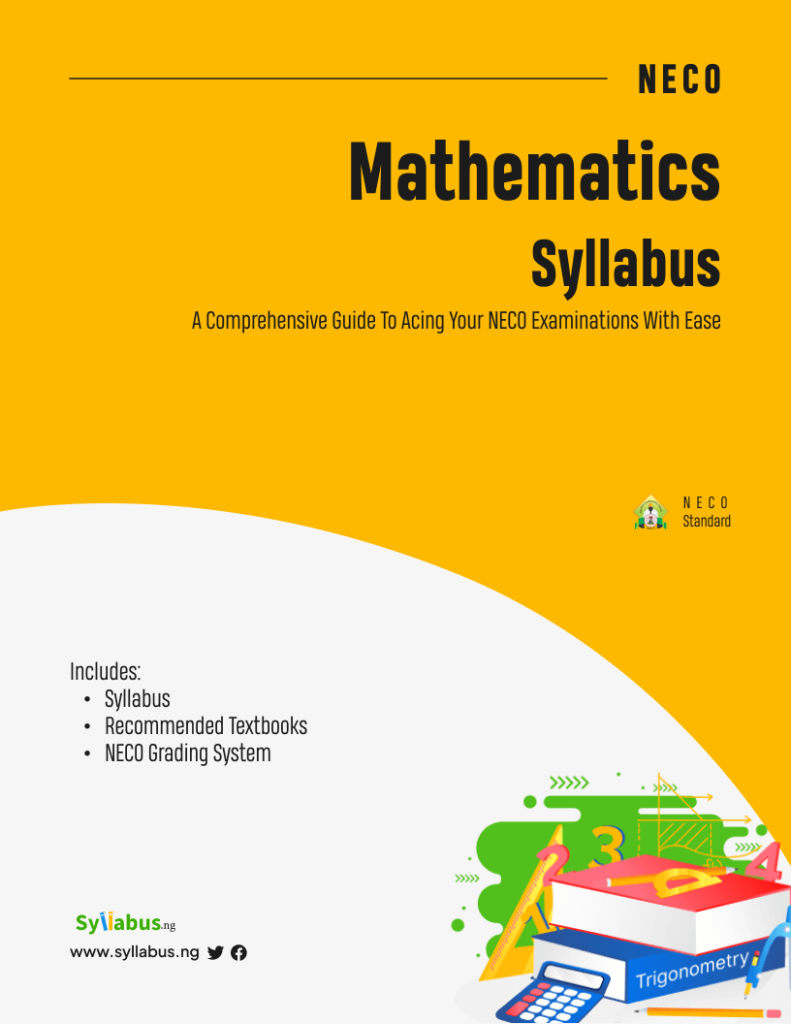NECO General Mathematics Syllabus
Are you writing General Mathematics in your NECO O’level exams? Download the recommended Mathematics syllabus to excel in your exams.

Home » NECO Syllabus » NECO General Mathematics SyllabusAbout NECO General Mathematics Syllabus
Mathematics is one of the four important subjects in the NECO exams. Without a credit in it, you can’t get admitted into a higher institution.
Having a trusted guide who will give you all the insider tips on how the exam will look is a must. With this syllabus, you get just that.
By studying this syllabus, you’re not just prepping for an exam; you are also laying down a solid math foundation for life. Imagine confidently tackling everyday challenges, from algebraic expressions to statistics.
This NECO General Mathematics syllabus is your ticket to success in your math exam so download and study.
Marking Guide & Sections
There will be two papers, Papers 1 and 2, both of which must be taken.
PAPER 1:
This will consist of fifty multiple-choice objective questions, drawn from the common areas of the syllabus, to be answered in 1½ hours for 50 marks.
PAPER 2:
It will consist of thirteen essay questions in two sections – Sections A and B, to be answered in 2½ hours for 100 marks. Candidates will be required to answer ten questions in all.
Section A -Will consist of five compulsory questions, elementary carrying a total of 40 marks. The questions will be drawn from the common areas of the syllabus.
Section B – Will consist of eight questions of greater length and difficulty. The questions shall include a maximum of two which shall be drawn from parts of the syllabuses which may not be peculiar to candidates’ home countries.
Candidates will be expected to answer five questions for 60 marks.
Download NECO Mathematics Syllabus

Best candidates excel because they study smart and hard. Know what’s expected of you.
Download the NECO recommended Mathematics syllabus.
The NECO General Mathematics Syllabus
| GENERAL MATHEMATICS | ||
| SN | TOPICS | OBJECTIVES |
| 1 | NUMBER AND NUMERATION | 1.1 Number bases i. conversion of numbers from one base to another ii. Basic operations on number bases 1.2 Modular Arithmetic (i) Concept of Modulo Arithmetic. (ii) Addition, subtraction and multiplication operations in modulo arithmetic. (iii) Application to daily life. 1.3 Fractions, Decimals and Approximations (i) Basic operations on fractions and decimals. (ii) Approximations and significant figures 1.4 Indices (i) Laws of indices (ii) Numbers in standard form(scientific notation) 1.5 Logarithms (i) Relationship between indices and logarithms e.g. y = 10k implies log10y = k. (ii) Basic rules of logarithms e.g.log10(pq) = log10p + log10q log10(p/q) = log10p – log10q log10pn = nlog10p. (iii) Use of tables of logarithms and antilogarithms. 1.6 Sequence and Series (i)Patterns of sequences. (ii)Arithmetic progression (A.P.) Geometric Progression (G.P.) 1.7 Sets (i)Idea of sets, universal sets, finite and infinite sets,subsets, empty sets and disjoint sets. Idea of and notation for union, intersection and complement of sets. (ii)Solution of practical problems involving classification using Venn diagrams. 1.8 Logical Reasoning -Simple statements. True and false statements. Negation of statements, implications. 1.9 Positive and negative integers, rational numbers -The four basic operations on rational numbers. 1.10 Surds (Radicals) -Simplification and rationalization of simple surds. 1.11 Matrices and Determinants ( i ) Identification of order, notation and types of matrices. (ii) Addition, subtraction, scalar multiplication and multiplication of matrices. (iii) Determinant of a matrix 1.12 Ratio, Proportions and Rates -Ratio between two similar quantities. -Proportion between two or more similar quantities. -Financial partnerships, rates of work, costs, taxes, foreign exchange, density (e.g. population), mass, distance, time and speed. 1.13 Percentages Simple interest, commission, discount, depreciation, profit and loss, compound interest, hire purchase and percentage error. 1.14 Financial Arithmetic (i) Depreciation/ Amortization. (ii) Annuities (iii) Capital Market Instruments 1.15 Variation -Direct, inverse, partial and joint variations. |
| 2 | ALGEBRAIC PROCESSES | 2.1 Algebraic expressions (i) Formulating algebraic expressions from given situations (ii) Evaluation of algebraic expressions 2.2 Simple operations on algebraic expressions ( i) Expansion (ii) Factorization (iii) Binary Operations 2.3 Solution of Linear Equations (i) Linear equations in one variable ( ii) Simultaneous linear equations in two variables. 2.4 Change of Subject of a Formula/Relation (i) Change of subject of a formula/relation (ii) Substitution 2.5 Quadratic Equations ( i ) Solution of quadratic equations (ii) Forming quadratic equation with given roots. (iii)Application of solution of quadratic equation in practical problems. 2.6 Graphs of Linear and Quadratic functions (i) Interpretation of graphs, coordinate of points, table of values, drawing quadratic graphs and obtaining roots from graphs. ( ii ) Graphical solution of a pair of equations of the form: y = ax2 + bx + c and y = mx + k (iii) Drawing tangents to curves to determine the gradient at a given point. 2.7 Linear Inequalities (i) Solution of linear inequalities in one variable and representation on the number line. (ii) Graphical solution of linear inequalities in two variables. (iii) Graphical solution of simultaneous linear inequalities in two variables 2.8 Algebraic Fractions Operations on algebraic fractions with: (i) Monomial denominators ii) Binomial denominators 2.9 Functions and Relations -Types of Functions. |
| 3 | MENSURATION | 3.1 Lengths and Perimeters (i)Use of Pythagoras theorem,sine and cosine rules to determine lengths and distances. (ii)Lengths of arcs of circles, perimeters of sectors and segments. (iii) Longitudes and Latitudes. 3.2 Areas ( i ) Triangles and special quadrilaterals – rectangles, parallelograms and trapeziums. (ii)Circles, sectors and segments of circles. (iii)Surface areas of cubes,cuboids, cylinder, pyramids,right triangular prisms,cones and spheres. 3.3 Volumes (i) Volumes of cubes, cuboids, cylinders, cones, right pyramids and spheres. (ii) Volumes of similar solids |
| 4 | PLANE GEOMETRY | 4.1 Angles (i)Angles at a point add up to 360o. (ii)Adjacent angles on a straight line are supplementary. (iii) Vertically opposite angles are equal. 4.2 Angles and intercepts on parallel lines (i) Alternate angles are equal. ( ii )Corresponding angles are equal. ( iii )Interior opposite angles are supplementary (iv) Intercept theorem. 4.3 Triangles and Polygons (i) The sum of the angles of a triangle is 2 right angles. (ii) The exterior angle of a triangle equals the sum of the two interior opposite angles. (iii) Congruent triangles. ( iv ) Properties of special triangles – Isosceles, equilateral, right-angled, etc (v) Properties of special quadrilaterals –parallelogram, rhombus, square, rectangle, trapezium. (vi )Properties of similar triangles. (vii ) The sum of the angles of a polygon (viii) Property of exterior angles of a polygon. (ix) Parallelograms on the same base and between the same parallels are equal in area. 4.4 Circles (i)Chords. (ii)The angle which an arc of a circle subtends at the centre of the circle is twice that which it subtends at any point on the remaining part of the circumference. (iii)Any angle subtended at the circumference by a diameter is a right angle. (iv)Angles in the same segment are equal. (v)Angles in opposite segments are supplementary. ( vi )Perpendicularity of tangent and radius. (vii )If a tangent is drawn to a circle and from the point of contact a chord is drawn, each angle which this chord makes with the tangent is equal to the angle in the alternate segment. 4.5 Construction ( i ) Bisectors of angles and line segments (ii) Line parallel or perpendicular to a given line. ( iii )Angles e.g. 90o, 60o, 45o, 30o, and an angle equal to a given angle. (iv) Triangles and quadrilaterals from sufficient data. 4.6 Loci Knowledge of the loci listed below and their intersections in 2 dimensions. (i)Points at a given distance from a given point. (ii)Points equidistant from two given points. ( iii)Points equidistant from two given straight lines. (iv)Points at a given distance from a given straight line. |
| 5 | COORDINATE GEOMETRY OF STRAIGHT LINES | (i)Concept of the x-y plane. (ii)Coordinates of points on the x-y plane. |
| 6 | TRIGONOMETRY | 6.1 Sine, Cosine and Tangent of an angle (i)Sine, Cosine and Tangent of acute angles. (ii)Use of tables of trigonometric ratios. (iii)Trigonometric ratios of 30o, 45o and 60o. (iv) Sine, cosine and tangent of angles from 0o to 360o. ( v )Graphs of sine and cosine. (vi)Graphs of trigonometric ratios . 6.2 Angles of elevation and depression (i)Calculating angles of elevation and depression. (ii)Application to heights and distances. 6.3 Bearings (i)Bearing of one point from another. (ii)Calculation of distances and angles |
| 7 | INTRODUCTORY CALCULUS | (i) Differentiation of algebraic functions. (ii) Integration of simple Algebraic functions. |
| 8 | STATISTICS AND PROBABILITY | 8.1 Statistics (i) Frequency distribution (ii) Pie charts, bar charts, histograms and frequency polygons (iii)Mean, median and mode for both discrete and grouped data. (iv)Cumulative frequency curve (Ogive). (v)Measures of Dispersion: range, semi inter-quartile/interquartile range, variance, mean deviation and standard deviation. 8.2 Probability (i)Experimental and theoretical probability. (ii)Addition of probabilities for mutually exclusive and independent events. iii) Multiplication of probabilities for independent events. |
| 9 | VECTORS AND TRANSFORMATION | 9.1 Vectors in a Plane -Vectors as a directed line segment. -Cartesian components of a vector -Magnitude of a vector, equal vectors, addition and subtraction of vectors, zero vector, parallel vectors, multiplication of a vector by scalar. 9.2 Transformation in the Cartesian Plane Reflection of points and shapes in the Cartesian Plane. -Rotation of points and shapes in the Cartesian Plane. -Translation of points and shapes in the Cartesian Plane. -Enlargement |
Recommended NECO General Mathematics Textbooks
1. Essential Mathematics for Senior Secondary School 2014 edition, Tonad Publisher.
2. Ofojebe Tochukwu All School Mathematics for SSS Book 1-3, Sunny Best Printer.
3. Macre M.F, Kalejaiye A.O, Chima Z.I, Garl G.U New General Mathematics for SSS Book 1-3, Pearson Education Limited.
4. Four-figure table
5. Johnson U. A. A Comprehensive Biology Textbook for Senior Secondary School, New Edition.
All NECO Syllabus
Frequently Asked Questions About the NECO General Mathematics Exams
The exam typically includes multiple-choice questions, and essay questions.
The exam is usually divided into two parts: Paper 1 (Objective) will last for 1 hour 30 minutes, and Paper 2 (Theory) will last for 2 hours 30 minutes.
The key is to study the topics in the NECO General Mathematics syllabus regularly and tackle a lot of past papers. Also don’t forget to review your notes and ask your teachers or friends for help if you are stuck on anything.
Yes, you can. You will be given a calculator during your WAEC Mathematics exam and you can use that for your NECO exams as well
Good question! Stick to the topics outlined in the syllabus. They are like your roadmap to success in your NECO General Mathematics exams. If you are unsure, ask your teacher for guidance on which area to prioritize.
Common mistakes include not reading questions carefully, poor time management, and not cross-checking your work before you submit.
Practice time management by timing yourself during practice tests and allocating time for each section of the exam.
Download NECO Mathematics Syllabus

Best candidates excel because they study smart and hard. Know what’s expected of you.
Download the NECO recommended Mathematics syllabus.











